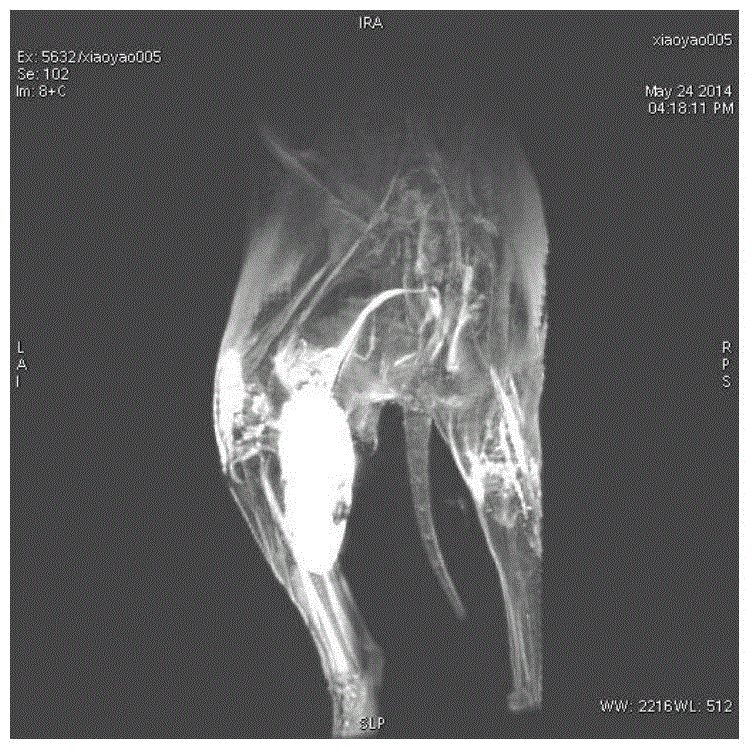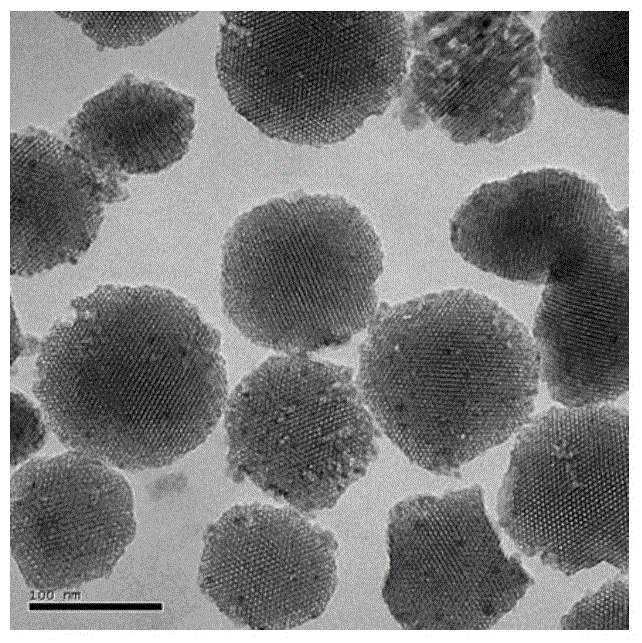Preparation method of multifunctional probe for tumor thermotherapy as magnetic resonance imaging contrast agent
A magnetic resonance contrast agent and multi-functional probe technology, which is applied in the field of nanomaterial preparation, can solve the problems of complex preparation process and tissue signal confusion, and achieve the effects of good stability, good biocompatibility and easy metabolism
- Summary
- Abstract
- Description
- Claims
- Application Information
AI Technical Summary
Problems solved by technology
Method used
Image
Examples
Embodiment 1
[0037] a. In deionized water with 520 parts by mass, add 20 parts of sodium diethyldithiocarbamate; The sodium carbamate aqueous solution is slowly added dropwise in the copper compound aqueous solution;
[0038] b. Magnetic stirring at room temperature for 4 hours, resulting in dark brown turbidity;
[0039] c. Add the precipitate obtained in b into 10 parts by mass of oleylamine, and continue stirring;
[0040] d. Put 30 parts by mass of oleylamine into a flask, heat at 80°C for 20 minutes, and pass through nitrogen to remove moisture and oxygen, then add the solution obtained in c into the flask, heat to 300°C, and stir magnetically 20 minutes. Then cool to room temperature, centrifuge at 10,000 rpm, wash with ethanol, and disperse with 100 parts of chloroform;
[0041] e. Mix 10 parts of the solution obtained in the above d with 100 parts by mass of a surfactant and 1000 parts of water, stir magnetically at 40°C for 48 hours, and then rotatably evaporate the resulting s...
Embodiment 2
[0047] a. In deionized water with 540 parts by mass, add 40 parts of sodium diethyldithiocarbamate; in deionized water with 540 parts by mass, add 60 parts of copper compound, diethyldithiocarbamate The sodium carbamate aqueous solution is slowly added dropwise in the copper compound aqueous solution;
[0048] b. Magnetic stirring at room temperature for 5 hours, resulting in dark brown turbidity;
[0049] c. Add the precipitate obtained in b into 30 parts by mass of oleylamine, and continue stirring;
[0050] d. Put 100 parts by mass of oleylamine into a flask, heat at 85°C for 30 minutes, and pass through nitrogen to remove moisture and oxygen, then add the solution obtained in c into the flask, heat to 300°C, and stir magnetically for 20 minutes. ~40 minutes. Then cool to room temperature, centrifuge at 10,000 rpm, wash with ethanol, and disperse with 110 parts of chloroform;
[0051] e. Mix 10 parts of the solution obtained in the above d with 110 parts by mass of surfa...
Embodiment 3
[0057] a. In deionized water with 550 parts by mass, add 50 parts of sodium diethyldithiocarbamate; The sodium carbamate aqueous solution is slowly added dropwise in the copper compound aqueous solution;
[0058] b. Magnetic stirring at room temperature for 6 hours, resulting in dark brown turbidity;
[0059] c. Add the precipitate obtained in b into 50 parts by mass of oleylamine, and continue stirring;
[0060] d. Put 100 parts by mass of oleylamine into a flask, heat at 80°C for 40 minutes, and pass through nitrogen to remove moisture and oxygen, then add the solution obtained in c into the flask, heat to 300°C, and magnetically stir 40 minutes. Then cool to room temperature, centrifuge at 12000 rpm, wash with ethanol, and disperse with 150 parts of chloroform;
[0061] e. Mix 10 parts of the solution obtained in the above d with 120 parts by mass of surfactant and 1500 parts of water, stir magnetically at 60°C for 72 hours, and then rotate the obtained solution at 50°C ...
PUM
 Login to View More
Login to View More Abstract
Description
Claims
Application Information
 Login to View More
Login to View More - R&D
- Intellectual Property
- Life Sciences
- Materials
- Tech Scout
- Unparalleled Data Quality
- Higher Quality Content
- 60% Fewer Hallucinations
Browse by: Latest US Patents, China's latest patents, Technical Efficacy Thesaurus, Application Domain, Technology Topic, Popular Technical Reports.
© 2025 PatSnap. All rights reserved.Legal|Privacy policy|Modern Slavery Act Transparency Statement|Sitemap|About US| Contact US: help@patsnap.com



